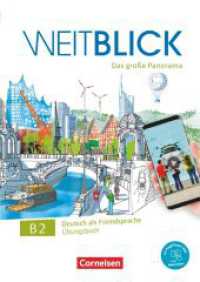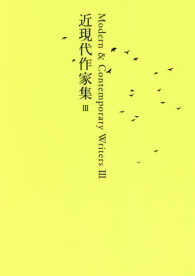- ホーム
- > 洋書
- > 英文書
- > Science / Mathematics
Full Description
This book is a collection of information about applying CRISPR-Cas systems for genome editing in plants. The main focus of this book is to address the recent advances and future prospects of CRISPR-Cas technology in crops.
Genome editing technology is important because it can be used to improve plant traits. The earlier genome-engineering tools, zinc finger nucleases (ZFNs), and TAL effector nucleases (TALENs) are complicated to design and not flexible. The novel genome editor, CRISPR-Cas systems, has advantages over ZFNs and TALENs. The advantages are simple and easy to design precision in targeting and efficiency. Due to its precision and simplicity, the CRISPR-Cas technology has rapidly become the most popular genome-editing platform in life-science fields. CRISPR-Cas technology has been used widely for human gene therapy to treat diseases and for plant breeding programs for crop improvement.
This book is of interest and useful to genome-editing professionals, plant breeders, horticulturists, field-level extension workers, nurserymen, planters, ecologists, and valuable source of reference to the relevant researchers.
Contents
Chapter 1-CRISPR-Cas: A History of Discovery and Innovation.- Chapter 2-Plant recombinant gene technology for pest control in XXI century: from simple transgenesis to CRISPR/Cas.- Chpater 3-Different classes of CRISPR-Cas systems.- Chapter 4-Strategies to control multidrug-resistant (MDR) bacterial infections using CRISPR-Cas technology.- Chapter 5-Redesigning Saccharomyces cerevisiae Meyen ex E.C. Hansen Using CRISPR to combat Industrial Needs.- Chapter 6 - CRISPRi Mediated Gene Silencing in Biofilm Cycle and Quorum Sensing.- Chapter 7- A new era of CRISPR technology to improve climate resilience in rice.- Chapter 8- Deciphering the role of CRISPR/Cas9 in the amelioration of abiotic and biotic stress conditions.- chapter 9-Detailed insight into various classes of CRISPR/Cas system to develop the future crops.- Chapter 10-Role of CRISPR-Cas and its application in mitigating plant stress.- Chapter 11-Application of CRISPR for plant-mediated resistance.- Chapter 12-Nutrient Biofortification in Crop Plants by the Crispr/Cas9 Technology: A Potential Approach for Sustainable Food Security.- Chapter 13 -CRISPR-Cas and its Applications in Food production.- Chapter 14 - Application of genome editing: CRISPR Cas in crop improvement.- Chapter 15-Development of a CRISPR-Cas9-based multiplex genome editing vector and stay-green lettuce.- Chapter 16-Potato Genome Editing: Recent Challenges and a Practical Procedure.- Chapter 17-CRISPR GENE Editing for Secondary Metabolite Production: A Review.- Chapter 18-CRISPR-CAS Systems for Enhancing Photosynthesis : Climate Resilience And Food Production.- Chapter 19 - Combined use of unidirectional site-specific recombination system and CRISPR-Cas systems for plant genome editing.- Chapter 20- Advances in delivery of CRISPR-Cas reagents for precise genome editing in plants.- chapter 21-Perspectives and overview of CRISPR/CAS Technology in Plant Pathogenesis.- Chapter 22- Clustered regularly interspaced short palindromic repeats (CRISPR)-associated proteins (Cas) [CRISPR-Cas] - an emering technique in plant disease detection and management.- Chapter 23-Application of genome editing for improving nematode resistance in plants: How far we progressed?.- Chapter 24-CRISPR-based Genetic Control Strategies for Insect Pests to Mitigate Classical Insecticidal Approaches.- Chapter 25-CRISPR-Based Approach: A Way Forward to Sustainable Development Goals (SDGs).- Chapter 26-CRISPR/Cas Technology: A Climate Saviour or a Genetic Pandora's Box?.- Chapter 27-An Analysis of Global Policies and Regulation on Genome Editing in Plants.- Chapter 28-CRISPR/Cas Mediated multiplex gene editing in Tomato (Solanum lycopersicum L.).- Chapter 29-CRISPR-Cas System and its Role in Quorum Sensing Processes of Bacteria and Fungi.- Chapter 30- Genome editing tool CRISPR-Cas: Legal and Ethical Considerations for Life Science.








